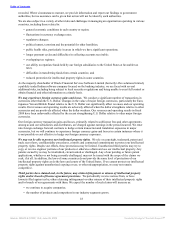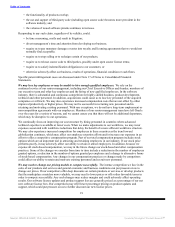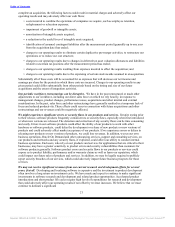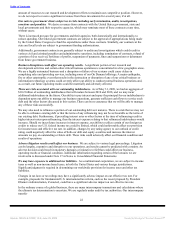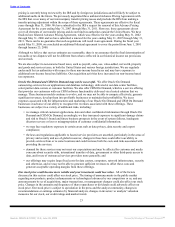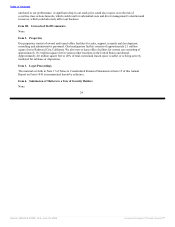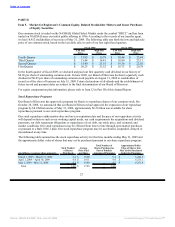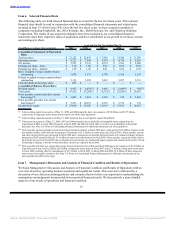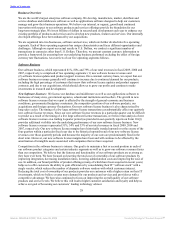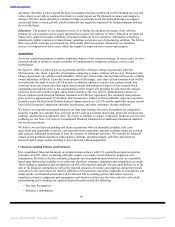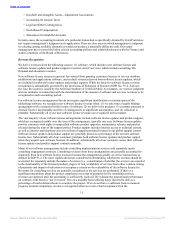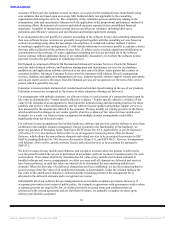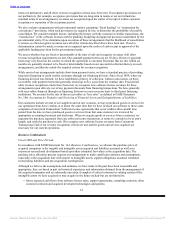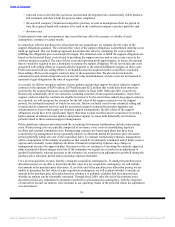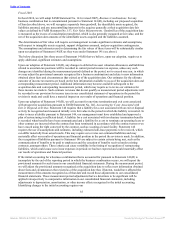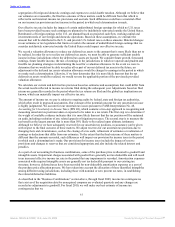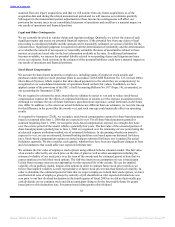Oracle 2008 Annual Report Download - page 33
Download and view the complete annual report
Please find page 33 of the 2008 Oracle annual report below. You can navigate through the pages in the report by either clicking on the pages listed below, or by using the keyword search tool below to find specific information within the annual report.
Table of Contents
Business Overview
We are the world’s largest enterprise software company. We develop, manufacture, market, distribute and
service database and middleware software as well as applications software designed to help our customers
manage and grow their business operations. We believe our internal, or organic, growth and continued
innovation with respect to our software products and services offerings provide the foundation for our
long-term strategic plan. We invest billions of dollars in research and development each year to enhance our
existing portfolio of products and services and to develop new products, features and services. Our internally
developed offerings have been enhanced by our acquisitions.
We are organized into two businesses, software and services, which are further divided into five operating
segments. Each of these operating segments has unique characteristics and faces different opportunities and
challenges. Although we report our actual results in U.S. Dollars, we conduct a significant number of
transactions in currencies other than U.S. Dollars. Therefore, we present constant currency information to
provide a framework for assessing how our underlying business performed excluding the effect of foreign
currency rate fluctuations. An overview of our five operating segments follows.
Software Business
Our software business, which represented 81%, 80% and 79% of our total revenues in fiscal 2009, 2008 and
2007, respectively, is comprised of two operating segments: (1) new software license revenues and
(2) software license updates and product support revenues. On a constant currency basis, we expect that our
software business revenues generally will continue to increase due to continued demand for our products,
including the high percentage of customers that renew their software license updates and product support
contracts, and due to our acquisitions, which should allow us to grow our profits and continue to make
investments in research and development.
New Software Licenses: We license our database and middleware as well as our applications software to
businesses of many sizes, government agencies, educational institutions and resellers. The growth in new
software license revenues that we report is affected by the strength of general economic and business
conditions, governmental budgetary constraints, the competitive position of our software products, our
acquisitions and foreign currency fluctuations. Our new software license business is also characterized by
long sales cycles. The timing of a few large software license transactions can substantially affect our quarterly
new software license revenues. Since our new software license revenues in a particular quarter can be difficult
to predict as a result of the timing of a few large software license transactions, we believe that analysis of new
software license revenues on a trailing 4-quarter period (as provided in our quarterly reports on Form 10-Q)
provides additional visibility into the underlying performance of our new software license business. New
software license revenues represented 31%, 34% and 33% of our total revenues in fiscal 2009, 2008 and
2007, respectively. Our new software license margins have historically trended upward over the course of the
four quarters within a particular fiscal year due to the historical upward trend of our new software license
revenues over those quarterly periods and because the majority of our costs are predominantly fixed in the
short term. However, our new software license margins have been and will continue to be affected by the
amortization of intangible assets associated with companies that we have acquired.
Competition in the software business is intense. Our goal is to maintain a first or second position in each of
our software product categories and certain industry segments as well as to grow our software revenues faster
than our competitors. We believe that the features and functionality of our software products are as strong as
they have ever been. We have focused on lowering the total cost of ownership of our software products by
improving integration, decreasing installation times, lowering administration costs and improving the ease of
use. In addition, our broad portfolio of product offerings (many of which have been acquired in recent years)
helps us to offer customers the ability to gain efficiencies by consolidating their IT “software stack” with a
single vendor, which reduces the number of disparate software vendors with which customers interact.
Reducing the total cost of ownership of our products provides our customers with a higher return on their IT
investments, which we believe creates more demand for our products and services and provides us with a
competitive advantage. We have also continued to focus on improving the overall quality of our software
products and service levels. We believe this will lead to higher customer satisfaction and loyalty and help us
achieve our goal of becoming our customers’ leading technology advisor.
28
Source: ORACLE CORP, 10-K, June 29, 2009 Powered by Morningstar® Document Research℠


